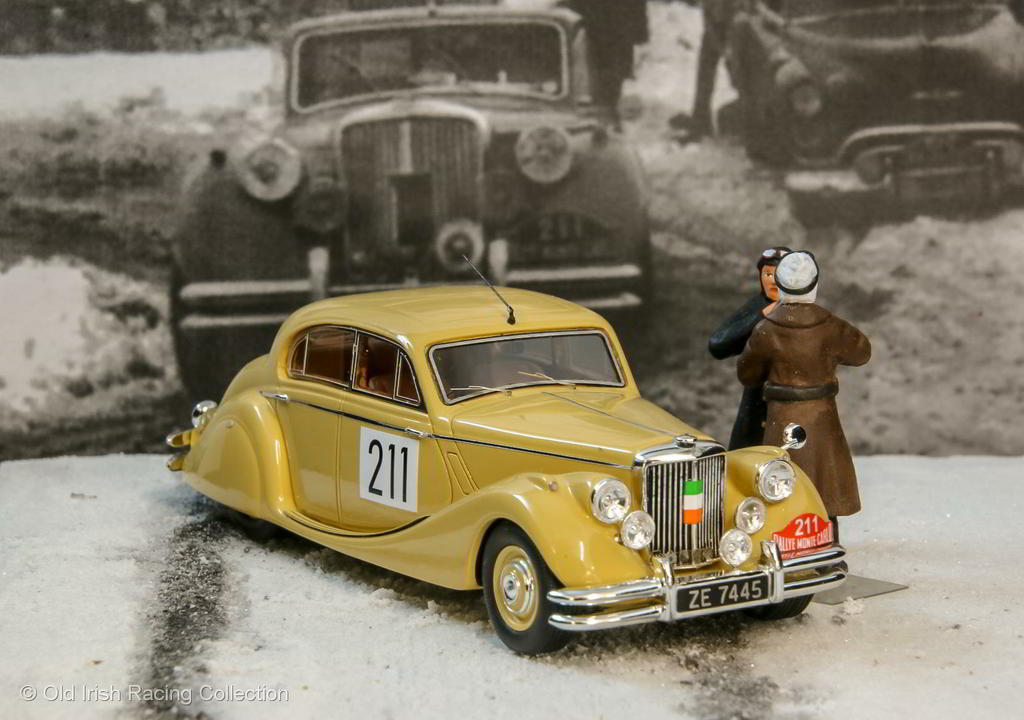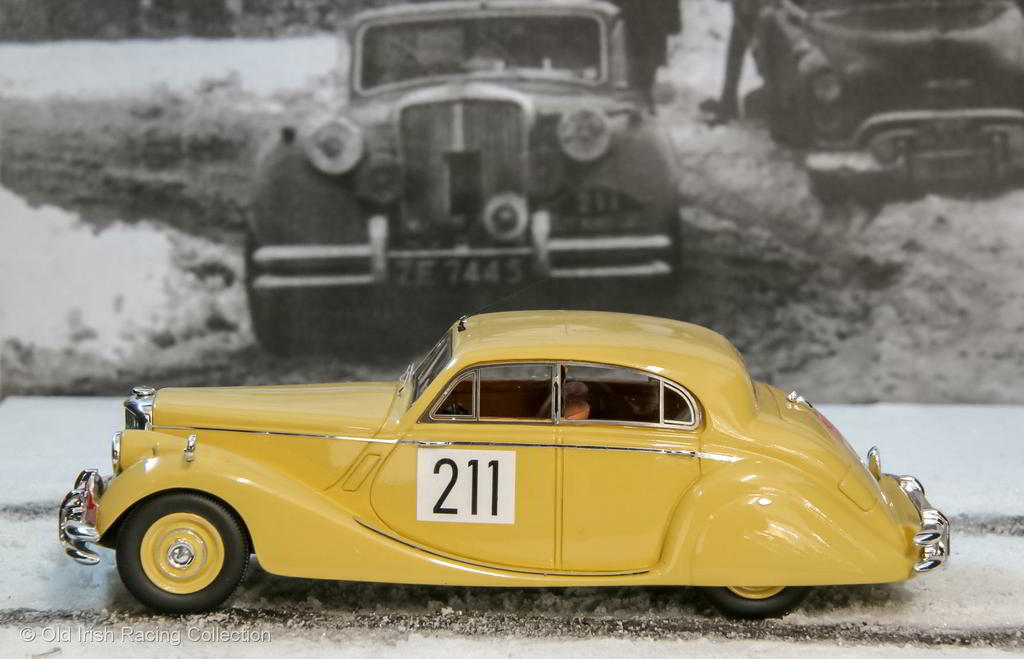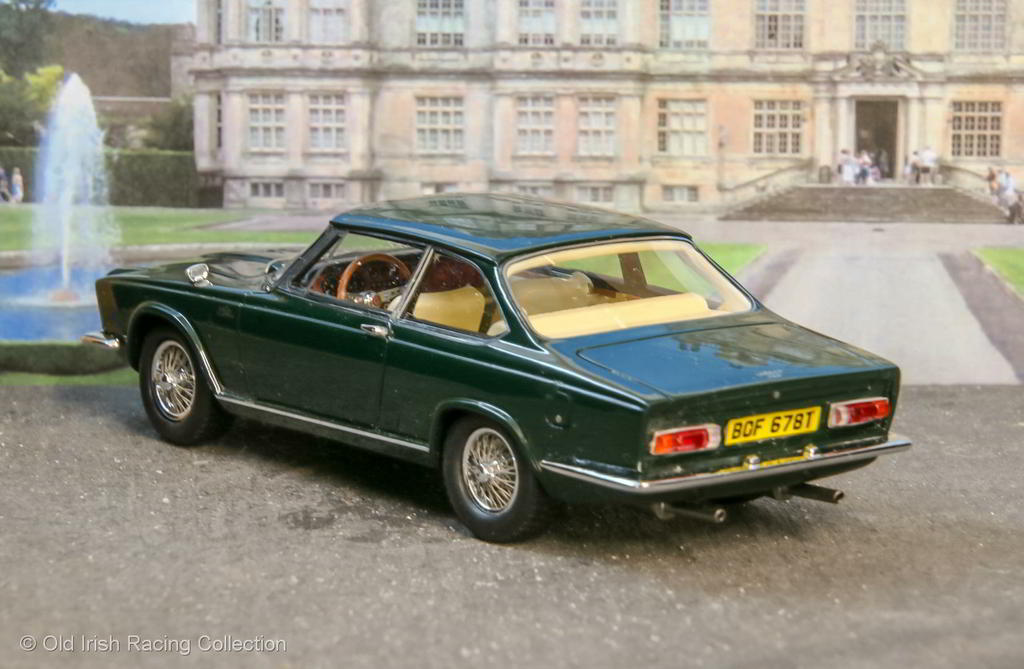|
|
Post by JSB33 on Nov 4, 2022 8:19:26 GMT -5
That last picture is a stunner!
|
|
|
|
Post by jager on Nov 4, 2022 20:21:08 GMT -5
You’ll have to explain to me your wavering on adding the 3rd placed car from Ireland - that just doesn’t compute. I loved the bit about borrowing the car from his mother-in-law!
|
|
|
|
Post by 105epaul on Nov 6, 2022 10:31:49 GMT -5
I do like the Jags, I need to get one of the Mk1 saloon racers and that MkV is lovely as are the other two examples made. As for the shootout between Sopwith and Sears (a lovely man who I met a few times) it was done at a very wet Brands Hatch (my old local track) in two Riley One Point Five saloons. The drivers each drove both Rileys and their aggregate time decided the winner which was Sears who was the quicker of the two by a couple of seconds. There is some rather grainy film of that on the internet, probably YouTube. I don't think a Jaguar ever won the BSCC outright, it was normally a driver from one of the smaller classes that took the title.
|
|
oldirish33
Member
"All Jaguars run on Guinness!"
Posts: 3,339
|
Post by oldirish33 on Nov 9, 2022 17:13:57 GMT -5
I saw these on the new announcements list and thought 'I will live vicariously through Jerry'.  Fantastic models, both of them. Love the last shot especially! Yes, like your addiction to VW, we both will have to live vicariously as you say through each others passions. Thanks! I thought that owning an old Jaguar was the antidote to a Jaguar addiction Jerry  (I can say this as an Italian car owner!). The Mark V is not what would normally spring to mind when thinking about a rally car, but they were different times. The 3.4 looks like a proper racer, very flash. I'm guessing that even in the land of Ford and Holden V8s, you are aware that 3.4s and their larger engined cousins won the first four Australian Touring car Championships, from 1960 through to 1963? Back then the Championship was decided in one race only, rather than a full series, but the Jaguars still reigned supreme. Far from the antidote Martin, its but the tip of the iceberg!  Jaguar was very successful with the big saloons as rally cars due to their performance, handling and comfort. I am a big Bob Jane fan. Thanks Paul! That last picture is a stunner! Thanks Jeff! As you know, small Jaguar saloons, the MK2 in particular, have been my passion for a good many years.  You’ll have to explain to me your wavering on adding the 3rd placed car from Ireland - that just doesn’t compute. I loved the bit about borrowing the car from his mother-in-law! You know me too well, see below.  I do like the Jags, I need to get one of the Mk1 saloon racers and that MkV is lovely as are the other two examples made. As for the shootout between Sopwith and Sears (a lovely man who I met a few times) it was done at a very wet Brands Hatch (my old local track) in two Riley One Point Five saloons. The drivers each drove both Rileys and their aggregate time decided the winner which was Sears who was the quicker of the two by a couple of seconds. There is some rather grainy film of that on the internet, probably YouTube. I don't think a Jaguar ever won the BSCC outright, it was normally a driver from one of the smaller classes that took the title. I had forgotten that the Championship was decided by racing two heats of five laps in Marcus Chambers prepared Rileys. Much more exciting than the coin toss originally proposed! No, never an outright BSCC or BTCC Championship for Jaguar, but many great wins!  Jaguar MkV - 1951 Rallye Monte Carlo, 3rd - MATRIX Jaguar MkV - 1951 Rallye Monte Carlo, 3rd - MATRIXOne of the Jaguar MkV’s assembled in Dublin by Frank Cavey and Sons in 1950, the car was sold to Mrs. O’Connor Cox and generously lent to her son-in-law Cecil Vard to run on the Monte Carlo Rallye in 1951. She had good reason to trust him with her car. Vard was a successful racing/rally driver already and drove for the Frazer Nash team when not competing in his MG. A successful Dublin furrier and clothing manufacturer, Vard gained international recognition by taking 3rd overall on the Monte Carlo in 1951. It was one of two MkVs prepared by Caveys to run the rally in 1951. He must have been a favorite, because he was loaned the car again in 1953 Monte Carlo in which he finished 5th.  Vard recognized the advantage the MkV had in allowing him to transport three passengers in comfort. A relief driver (Bill Young) along with his navigator Arthur Jolley and back up navigator Doc Jackson. This allowed fresh drivers and navigators to tackle the constant snow and ice on often dark and steep mountain roads. To make their cold journey more comfortable in the cold, Vard had made a couple of fox fur lined sleeping bags. One of his modifications was a separate washer fluid reservoir that held salt water to combat the ice and snow build-up on the windscreen. Vard was given a Jaguar team drive in the new MkVII in 1954 (8th), 1955 (27th) and 1956 (DNF). He drove the successful MkVII in 1954 and 1956 that Stirling Moss had used in saloon car races (LWK 343). Jaguar won the Team Prize for its success on the Monte Carlo Rally in 1954 and 1955 and a MkVII was the outright winner in 1956.  A gentleman racer, over the years Vard drove a variety of cars in both circuit racing and rallies. He had one grand prix race, a non-championship run in an OSCA at the Irish Grand Prix in the mid-50’s. He was also a regular at the Tourist Trophy races held at the Ards Circuit in N. Ireland, driving for the Frazer Nash Team. He drove a Frazer Nash at Le Mans in 1955, which unfortunately expired early on in the race. He was also a regular on the Circuit of Ireland rally up until 1972 and was often drove his Porsche 911 on that rally. Vard would be the most successful Irish driver on the Monte Carlo Rally until Craig Breen equaled his 3rd place finish in 2022. Cecil Vard passed away at the age of 64 in 1987.  |
|
|
|
Post by Tom on Nov 9, 2022 17:37:47 GMT -5
What a great car and a great story. You'd buy it for the history alone, and on top of that it’s a great-looking car and model!
|
|
|
|
Post by Alfaholic on Nov 9, 2022 20:17:47 GMT -5
That's an unusual colour on a Jaguar saloon isn't it? I do like it though.
|
|
|
|
Post by reeft1 on Nov 10, 2022 3:46:50 GMT -5
That's a cracker
|
|
|
|
Post by jager on Nov 10, 2022 8:31:54 GMT -5
That's a real beauty Jerry. All it needs is some 1:43 sleeping bags in the back seat!
|
|
|
|
Post by 105epaul on Nov 10, 2022 12:55:42 GMT -5
I am getting so tempted by these but I fear resistance will be futile. Great story too.
|
|
oldirish33
Member
"All Jaguars run on Guinness!"
Posts: 3,339
|
Post by oldirish33 on Nov 11, 2022 11:19:45 GMT -5
What a great car and a great story. You'd buy it for the history alone, and on top of that it’s a great-looking car and model! Thanks Tom! I didn't know much about the 1951 Monte Carlo effort until I bought the models and started doing research. I found it interesting that Jaguar's rallying success in the early 1950's came from drivers from Ireland and N. Ireland. That's an unusual colour on a Jaguar saloon isn't it? I do like it though. I am not an authority on early Jaguar saloons, but believe according to my reference material it is a color they called Honeysuckle and I don't think it was all that common. Most of the MkV's seem to be in more sedate darker colors, or white and most seem to have been two-tone. I'm surprised this one was a solid color, but I have not uncovered enough information on the knock down cars assembled in Ireland to know if the bodies came painted. At that time, Jaguar frequently produced bespoke color combinations for customers and literature states that cars could be ordered in custom colors. I did find this car that appears to be a two-tone Honeysuckle car of original provenance. The Matrix color comes close to this. For the 1953 Monte Carlo, they painted the front of the front fenders white, although I don't have definite explanation as to why. I speculate that it was to contrast the front fenders enough after they had accumulated enough dirt and grime from the roads to be able to accurately see the end and edges of the car when negotiating tight bends, particularly in the Alps, at night.  Thanks! That's a real beauty Jerry. All it needs is some 1:43 sleeping bags in the back seat! I'll get right on that!  I am getting so tempted by these but I fear resistance will be futile. Great story too. Yes it is Paul, as you can see I fell into that hole. Glad I did though, they are lovely models! |
|
oldirish33
Member
"All Jaguars run on Guinness!"
Posts: 3,339
|
Post by oldirish33 on Nov 20, 2022 13:01:17 GMT -5
British Maserati? - In 1966, Frua created and built a one-off coupe design for a customer based on the Jaguar 3.8S saloon. Carrying design elements of Frua's Maserati Quattroporte, the stylish coupe debuted at the 1966 Geneva Auto Show. Just as the similar Jaguar based coupe Bertone introduced at the same show was overshadowed by the Lamborghini Miura, the Frua coupe appeared on the same stand as Frua's take on the Jaguar E-Type FHC made for Jaguar dealer and race tuner John Coombs. It was also the show Jaguar's new E-Type 2+2 Coupe was introduced. Did Frua's Italian design improve on the classic looks of the small Jaguar saloon it was based on? 1966 Jaguar S-Type Frua - Matrix
In 1966, Pietro Frua transformed the iconic shape of the Jaguar 3.8S into a stylish two-door coupe. The one-off Jaguar coupe was commissioned by fellow Italian, Francesco Respino. A rolling floor pan and drivetrain were delivered to the small Turin carrozzerie, the naked chassis (1B78869DN) was acquired from Jaguar through the Turin Jaguar dealer Fattori e Montani. It was a left-hand drive car with a 3.8 liter engine and manual transmission with overdrive. In three months, Frua bodied the car and had it ready for the 1966 Geneva Auto Show, where it appeared next to Frua’s restyled E-Type Coupe done for John Coombs.  Frua was a small firm and unlike larger design firms such as Pinninfarina, positioned to accept single commissions. Best known for its designs for Maserati, several Maserati design elements appear in the Frua S-Type. The twin headlamps, C-pillar and rear quarter panels are reminiscent of Frua’s Maserati Quattroport. Frua used the original Jaguar dash and rear seat but incorporated a Maserati steering wheel and front bucket seats into the car’s interior. Originally painted opalescent light blue, the car was repainted British Racing Green after Respino sold he car to a Swiss buyer in the late 60’s. The car was sold to a UK buyer in 1978 and subsequently underwent a complete restoration and returned to its original color. It has remained in the UK under the care of several owners since.  The Frua and Bertone coupes introduced at Geneva in 1966. I like the overall look of the Frua coupe better, it seems to be less fussy and more sporty looking. Why the big scuttle vent though? It seems akward.  Iconic look meets the future. While I appreciate and love the older Jaguar design, I also love the Frua design. I originally ordered this Matrix model in the BRG because I thought I liked it better. Now I am having second thoughts about not getting the light blue version.  
|
|
|
|
Post by Tom on Nov 20, 2022 13:31:18 GMT -5
That is fantastic. I agree with the Maserati association, it's what I'd say if I had to guess. Superb model, love the colour too.
|
|
|
|
Post by Alfaholic on Nov 20, 2022 23:13:59 GMT -5
I think that out of those 3 I would take the Frua. I would put the original above the Bertone though, it's just too fussy as you say.
|
|
|
|
Post by DeadCanDanceR on Nov 21, 2022 0:21:25 GMT -5
Loved the comparison photo of the Frua and Bertone Jaguars! Jaguar "Mexicos"?  |
|
|
|
Post by MG Rocks On on Nov 21, 2022 3:10:25 GMT -5
I think that out of those 3 I would take the Frua. I would put the original above the Bertone though, it's just too fussy as you say. My thoughts too. |
|